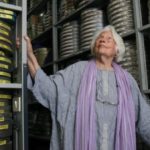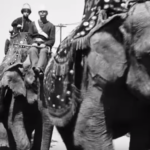Film Archivists Preserve Accounts of What COVID-19 Has Wrought
How is the Covid-19 pandemic disrupting the work of film archivists and archives?
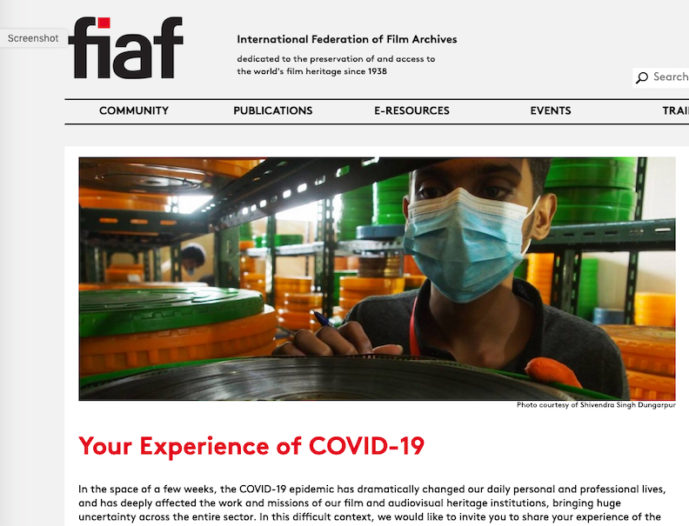
Christophe Dupin, who as Senior Administrator runs the day-to-day operations of the International Federation of Film Archivists, wants to know.
“Being an historian, myself, I always think about the future and what we want historians in 20 or 30 years to remember about this,” says Dupin. “If we document what the experience is now, it could be very useful in the future.”
He has asked archivists around the world to relate how the Covid-19 pandemic has affected them via an online site.
FIAF created the online forum early in May, hoping that members of the global moving-image preservation and archiving community would contribute their experiences of the crisis, personal and professional.
Dupin and his FIAF colleagues noted, unsurprisingly, that the Covid-19 pandemic had rapidly and profoundly altered the way archives pursue their mission of preserving and sharing the world’s film and audiovisual heritage.
That had come with “huge uncertainty across the entire sector,” FIAF’s announcement said.
Perhaps, it continued, archivists would benefit from talking to each other in a public archivists’ forum, no doubt supplementing many smaller conversations.
How, FIAF asked, had the developments affected archivists’ jobs? How had they reshaped institutions’ day-to-day operations? Were archivists afraid that they would lose their jobs? How many had already lost them, or had at least been temporarily laid off?
How were their institutions and their professional networks faring?
And, crucially, could archivists suggest approaches that their colleagues could use to deal with the crisis — “or perhaps even reflect on how a crisis that has brought the world to its knees could perhaps be a rare window of opportunity to build a more resilient and sustainable future for our sector.”
In an interview, Christophe Dupin said that events have been happening so fast that it’s likely that, in a few months, and certainly in a few years, moving-image archivists will be unable to recall precisely how the pandemic unfolded. They might have worked hard, in fact, to erase from their memories how Covid-19 disrupted the operations of national film archives, private collections, and collections at museums and other cultural institutions.
Dupin said he set up the site because he could hardly miss the sense of urgency among colleagues around the world as the crisis mounted. “In my position as administrator of FIAF I am the contact point for colleagues at 169 institutions around the world,” he said. “I thought it would be great to offer a platform so my colleagues could feel a little less isolated — so they could share their concerns and also their thoughts on how we can get out of this situation and what the new world will look like for our sector.”
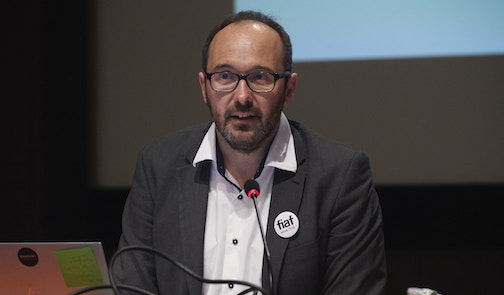
Christophe Dupin of FIAF
One part of that future, he is certain, will be greater collaboration among archives. He expects “even more solidarity.”
For now, he is seeing disruption on a scale so large it is even threatening FIAF’s own operations. The organization’s annual convention was to have been held at the end of April in Mexico, and “it is always our big event of the year,” a crucial opportunity for networking. But “almost overnight we had to curtail all our physical activities, and cancel the event,” he said. “All our colleagues around the world were in the process of booking flights and hotels.”
Ironically, the theme of the symposium was to have been “preventing and managing natural and human-made disasters in film archives.”
A further blow to FIAF has been that a few members and member organizations have already been reporting that they might not be able to pay their annual FIAF dues. “If they say that, it means they’re in deep trouble,” Dupin said. “Obviously that’s a problem for us, too, because FIAF can only function if members pay their fees.”
Are archivists reluctant to speak up?
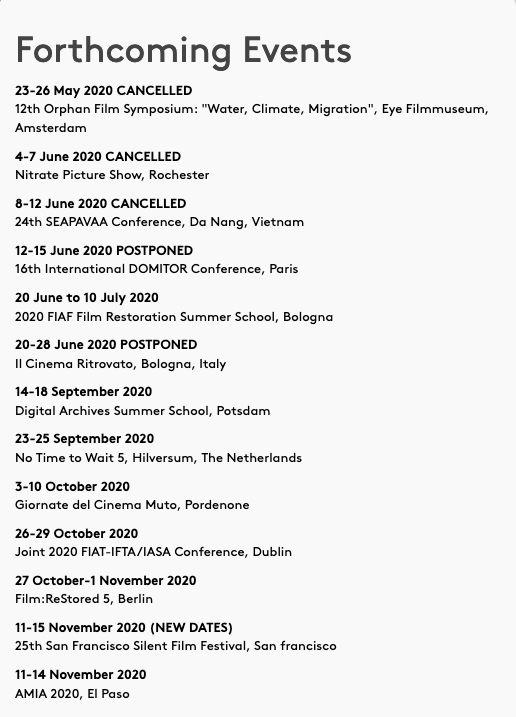
FIAF’s calendar of forthcoming events: a dismal image
Dupin said he also started to hear about colleagues around the world who had become sick — “some were very sick, and it was very worrying,” he said. “So I wanted to share that information with some of my colleagues and friends I’ve seen at various events and congresses.”
The reports he was receiving are reflected now on the FIAF Covid-19 online bulletin board — closures, lay-offs, and other outcomes, such as suddenly having to compete with videogame-playing family members for access to home computers.
Dupin noted that while some of the first reports posted on the site have powerfully evoked what moving-image archivists are dealing with, the number of posts has been low. “I’m a little disappointed by the lack of reactions, so far,” Dupin said.
He has tried some of the usual tricks, including making friends contribute, but still the response lags.
Of course, he acknowledged, everyone is busy under the stresses of a pandemic, “trying to keep various balls in the air” while in most cases away from their workplaces. But still…
He has theories about why archivists have been shy about sharing their experiences. Many, he suspects, are anxious about appearing to presume to speak for their institutions and organizations. That has disappointed and even perturbed him, he said.
“Some colleagues told me confidentially, informally, that they didn’t think they could actually share their personal experiences because they didn’t think their institutions would allow it, and their institutions would only allow the official perspective on how they have reacted to this crisis.”
He continued: “I understand that, but it’s a bit of a shame because in times like this you also want to hear about the difficulties, not just about how the archives in our network have responded splendidly and swiftly to this crisis.”
Another cause of scant reporting, so far, probably is that moving-image archivists, like workers in many fields, simply are traumatized by what has happened. That makes it all the more important, Dupin said, that they share details of “the many unsolved problems, and the hardships.”
That archivists would keep quiet because fearful of official rebuke “was a difficulty I hadn’t anticipated,” he said. But if colleagues in some countries and kinds of institutions are reluctant, “we’ll have to accept that.”
After all, he said, many archives rely on governments to provide budgets and pay salaries. He said that is particularly unsettling, looking ahead, to “the deep economic recession that’s coming, because governments rarely choose film archives as their priority for funding.”
What archivists are reporting
The first reports on the FIAF platform indicate that archives of all varieties are struggling, but also battling on.
Loss of income is, of course, a major concern. With a near-total cessation of paid visits to archives and associated cinemas, independent and university-based regional film archives are among many kinds of institutions have been hard hit. They are reporting that they may not survive if governments or other backers do not provide financial assistance.
Some of the work of archives can be handled by technicians and other staff in their homes. Jon Wengström of Svenska Filminstitutet reported, for example, that staff could take home flat-bed scanners and work on such tasks as image digitization and color correction, even though at lower efficiency and output. But not all crucial tasks can go home with staff, noted Angela Doane of the British Film Institute. “Water tanks get algae build-up if not flushed, soft plastic equipment parts become misshapen if left unmoved, and so on,” she wrote. She said that, to state the obvious, maintaining film is a physical task; it requires retrieving film from vaults, and then working on it.
Paula Félix-Didier of the Museo Del Cine Pablo C. Ducros Hicken in Buenos Aires, which was established on 1971 and holds 65,000 reels of film, agreed. “Our collections are not prepared to be left alone for so many days,” she wrote. “Precarious climate-control equipment tends to break or malfunction when not attended, and heavy rain or power shutdowns are a daily threat.”
When her archive had to close suddenly, she found herself the only staff member able to check on the collections. “I became administrator, conservator, responsible for maintenance and cleanliness, coordinator of communications, and more.”
She and one security guard made the rounds to ensure that air conditioners were working. She swept the roof to prevent dry leaves from blocking drains above the institution’s nitrate vault, and checked on its collections and library.
“It is a sad spectacle to see empty spaces where so much activity used to happen,” she wrote.
Catching up, at least
With public visits and many other kinds of work curtailed, staff at many archives have taken the opportunity to clear backlogs of work. They have worked on grant applications, website content and design, databases, and the like.
 Many have been active in boosting their Internet presence, seeking to connect to audiences in a way that is not new, but generally they didn’t use prominently, until now. The Kinemathek Bern, in Switzerland, Stefan Humbel reported, decided to continue its weekly program of themed screenings from its own archive, called Le Dimanche du Lichtspiel (right). It screens rare films with vintage projectors, with accompanying commentary. From late March, the series pressed on but with a twist: it went online, via Vimeo. That at least has allowed Kinemathek Bern to keep in touch with its audience, Humbel said.
Many have been active in boosting their Internet presence, seeking to connect to audiences in a way that is not new, but generally they didn’t use prominently, until now. The Kinemathek Bern, in Switzerland, Stefan Humbel reported, decided to continue its weekly program of themed screenings from its own archive, called Le Dimanche du Lichtspiel (right). It screens rare films with vintage projectors, with accompanying commentary. From late March, the series pressed on but with a twist: it went online, via Vimeo. That at least has allowed Kinemathek Bern to keep in touch with its audience, Humbel said.
The Yale Film Study Center adopted a similar approach, wrote Brian Meacham. It began to create online resources, starting with a film that was to have run on 1 May 2020 to mark the 50th anniversary of the Mayday demonstrations in New Haven, where Yale University is located. The 1970 documentary Mayday was to have been screened with a 16mm preservation print, with some of the filmmakers there to talk about the work.
Instead, the Yale center screened the film on Vimeo — a first, for it. Meacham interviewed two of the filmmakers via a publicly accessible Zoom stream.
Similar online events have followed.
As some of the FIAF bulletin board’s posters have noted, the pandemic has had one benefit: they have been forced to find innovative ways to connect with audiences, and that has strengthened the online presence of many.
At the British Film Institute, wrote Angela Doane, the pandemic has forced her and her colleagues to focus more on electronic access. She noted that viewings of free archival material on the Institute’s BFI Player have increased fourfold. Similarly, footage sales have risen. “With so little film and television being newly produced there has been a big rise in the desire to make archivally based programmes,” she wrote.
The increase in online viewing has, of course, been a long-term trend, noted Jurij Meden of the Austrian Film Museum. It is a trend that “has been steadily emptying movie theaters all over the world already for two decades.
“To be more precise: the crisis not only accelerated, but enthroned this trend of domestic viewing as the only legal option.”
Presumably few of his colleagues around the world would disagree with him, however, when he says that because the core mission of film museums includes preserving its audience, once the crisis abates archivists will be eager to revive the “idea of a film museum as a public space.”
Preserving the pandemic
When they do, wrote the BFI’s Angela Doane, part of their work will be to preserve and screen film that depicts outcomes and aspects of the pandemic. For BFI, she said, that already includes material preserved as part of the BFI #BritainOnLockdown campaign. The material ranges from the cautionary to the charmingly bizarre to the terribly sad.
Never a good time for a major blow
Dupin said he has observed how resourceful his colleagues around the world can be. They speak of transferring knowledge gained during the Covid-19 crisis to operations after it recedes.
But still, he worries. “It’s not a good time for the profession to get so violent a hit,” he said. “Not that any time would be.”
The trend towards digitization may now be providing archives with opportunities to display and market their holdings, and to develop those capacities, but the trend also has been expensive. For archivists, but often not for government officials and members of the general public, it is no secret that making and caring for digital copies of analog films adds to the cost of operation — because, of course, both analog and digital versions must be carefully and expensively preserved.
Still, some archivists have reported on the FIAF site, they try to find positives within a very difficult crisis. They report that they are, for example, taking the time to prepare to institute improved approaches to storage, handling, lending, safety, and other aspects of moving image archiving.
Even busy work has its benefits, wrote Jon Wengström of Svenska Filminstitutet: “It keeps some of the more desperate thoughts at bay, and gives some sort of continuation of normality and meaning, and aspirations things will…get back to normal.”
While it is difficult to predict “what our new world will look like,” he said, he nonetheless is heartened by imagining “how all the archives of our network will be able to collaborate and show even more solidarity over the next few years.”
Here’s the FIAF website for contributing to the historical record on moving-image archivists’ experiences of the Covid-19 pandemic. Contributors can opt whether their contribution will be visible to any visitor, or only to fellow FIAF members.
Update (18 June 2020): FIAF will publish a selection of the contributions in extended and updated form in the next issue of its biannual Journal of Film Preservation.
— Peter Monaghan
Previous Post: Any Day is a Good Day for Smelling Movies
Next Post: George Eastman Museum Offers Films from its Collection, Free

